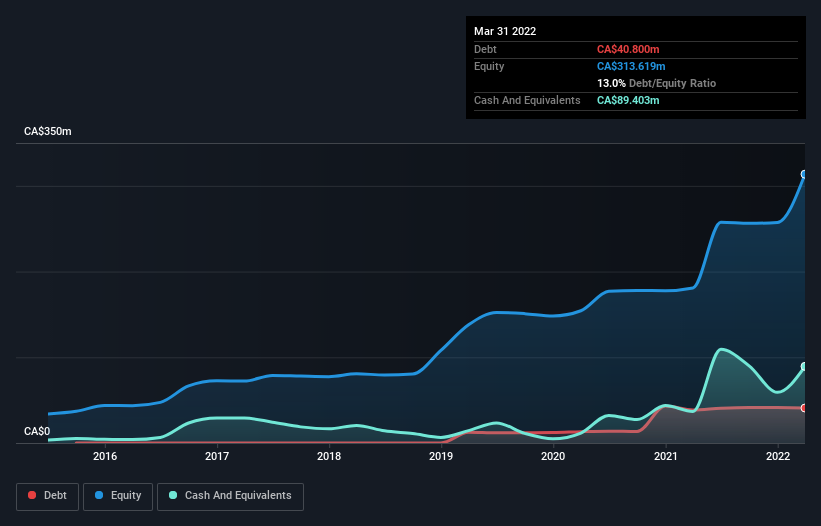Ascot Resources (TSE:AOT) Has Debt But No Earnings; Should You Worry?
Some say volatility, rather than debt, is the best way to think about risk as an investor, but Warren Buffett famously said that 'Volatility is far from synonymous with risk.' So it might be obvious that you need to consider debt, when you think about how risky any given stock is, because too much debt can sink a company. We note that Ascot Resources Ltd. (TSE:AOT) does have debt on its balance sheet. But the real question is whether this debt is making the company risky.
Why Does Debt Bring Risk?
Debt and other liabilities become risky for a business when it cannot easily fulfill those obligations, either with free cash flow or by raising capital at an attractive price. If things get really bad, the lenders can take control of the business. However, a more frequent (but still costly) occurrence is where a company must issue shares at bargain-basement prices, permanently diluting shareholders, just to shore up its balance sheet. Of course, plenty of companies use debt to fund growth, without any negative consequences. The first thing to do when considering how much debt a business uses is to look at its cash and debt together.
See our latest analysis for Ascot Resources
How Much Debt Does Ascot Resources Carry?
As you can see below, at the end of March 2022, Ascot Resources had CA$40.8m of debt, up from CA$38.6m a year ago. Click the image for more detail. However, it does have CA$89.4m in cash offsetting this, leading to net cash of CA$48.6m.
How Healthy Is Ascot Resources' Balance Sheet?
We can see from the most recent balance sheet that Ascot Resources had liabilities of CA$17.9m falling due within a year, and liabilities of CA$63.5m due beyond that. Offsetting this, it had CA$89.4m in cash and CA$1.32m in receivables that were due within 12 months. So it can boast CA$9.30m more liquid assets than total liabilities.
This short term liquidity is a sign that Ascot Resources could probably pay off its debt with ease, as its balance sheet is far from stretched. Succinctly put, Ascot Resources boasts net cash, so it's fair to say it does not have a heavy debt load! When analysing debt levels, the balance sheet is the obvious place to start. But ultimately the future profitability of the business will decide if Ascot Resources can strengthen its balance sheet over time. So if you want to see what the professionals think, you might find this free report on analyst profit forecasts to be interesting.
Since Ascot Resources has no significant operating revenue, shareholders probably hope it will develop a valuable new mine before too long.
So How Risky Is Ascot Resources?
By their very nature companies that are losing money are more risky than those with a long history of profitability. And the fact is that over the last twelve months Ascot Resources lost money at the earnings before interest and tax (EBIT) line. And over the same period it saw negative free cash outflow of CA$89m and booked a CA$7.0m accounting loss. With only CA$48.6m on the balance sheet, it would appear that its going to need to raise capital again soon. Even though its balance sheet seems sufficiently liquid, debt always makes us a little nervous if a company doesn't produce free cash flow regularly. When analysing debt levels, the balance sheet is the obvious place to start. However, not all investment risk resides within the balance sheet - far from it. We've identified 4 warning signs with Ascot Resources (at least 2 which are potentially serious) , and understanding them should be part of your investment process.
At the end of the day, it's often better to focus on companies that are free from net debt. You can access our special list of such companies (all with a track record of profit growth). It's free.
Have feedback on this article? Concerned about the content? Get in touch with us directly. Alternatively, email editorial-team (at) simplywallst.com.
This article by Simply Wall St is general in nature. We provide commentary based on historical data and analyst forecasts only using an unbiased methodology and our articles are not intended to be financial advice. It does not constitute a recommendation to buy or sell any stock, and does not take account of your objectives, or your financial situation. We aim to bring you long-term focused analysis driven by fundamental data. Note that our analysis may not factor in the latest price-sensitive company announcements or qualitative material. Simply Wall St has no position in any stocks mentioned.

 Yahoo Movies
Yahoo Movies 
